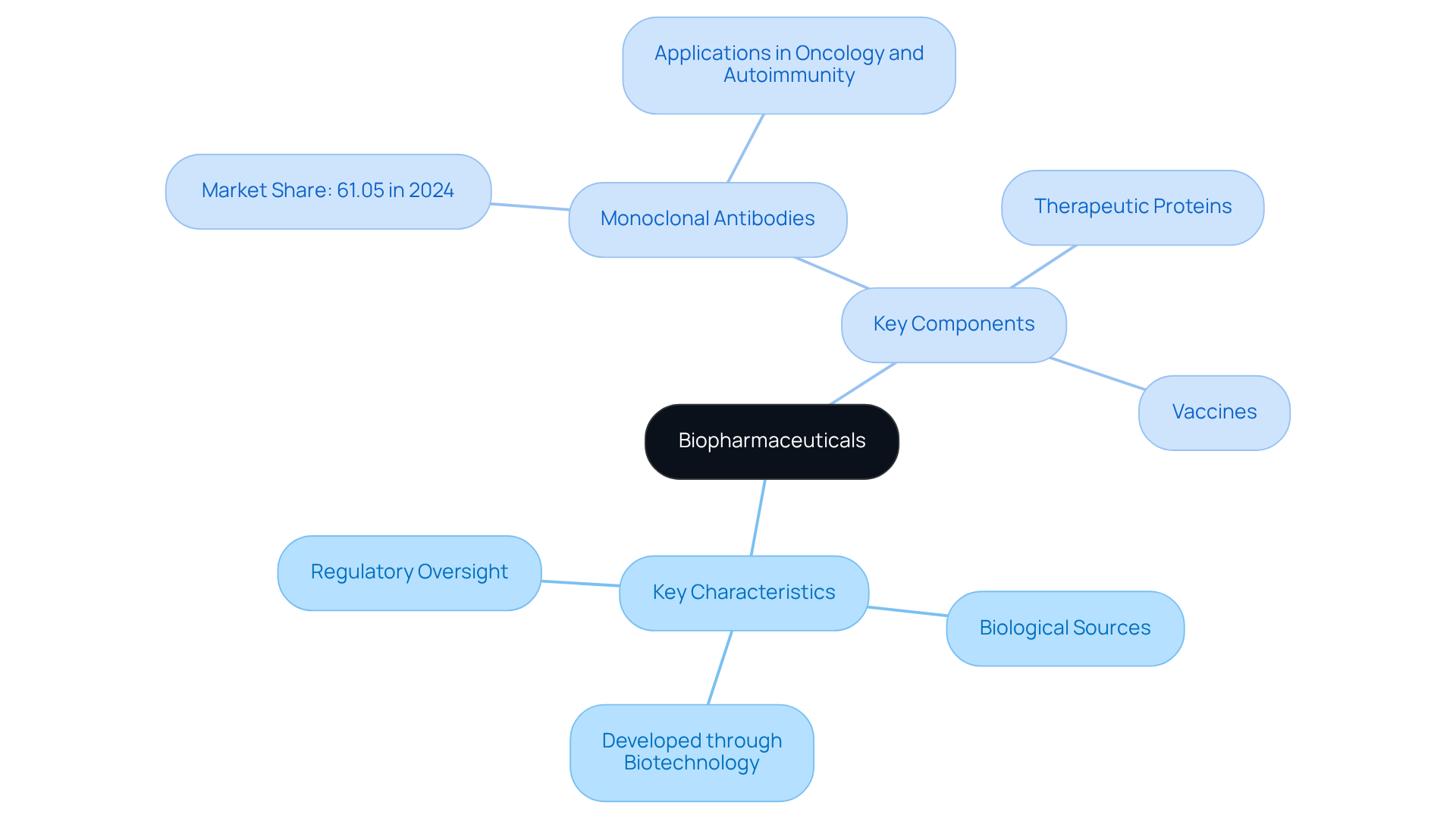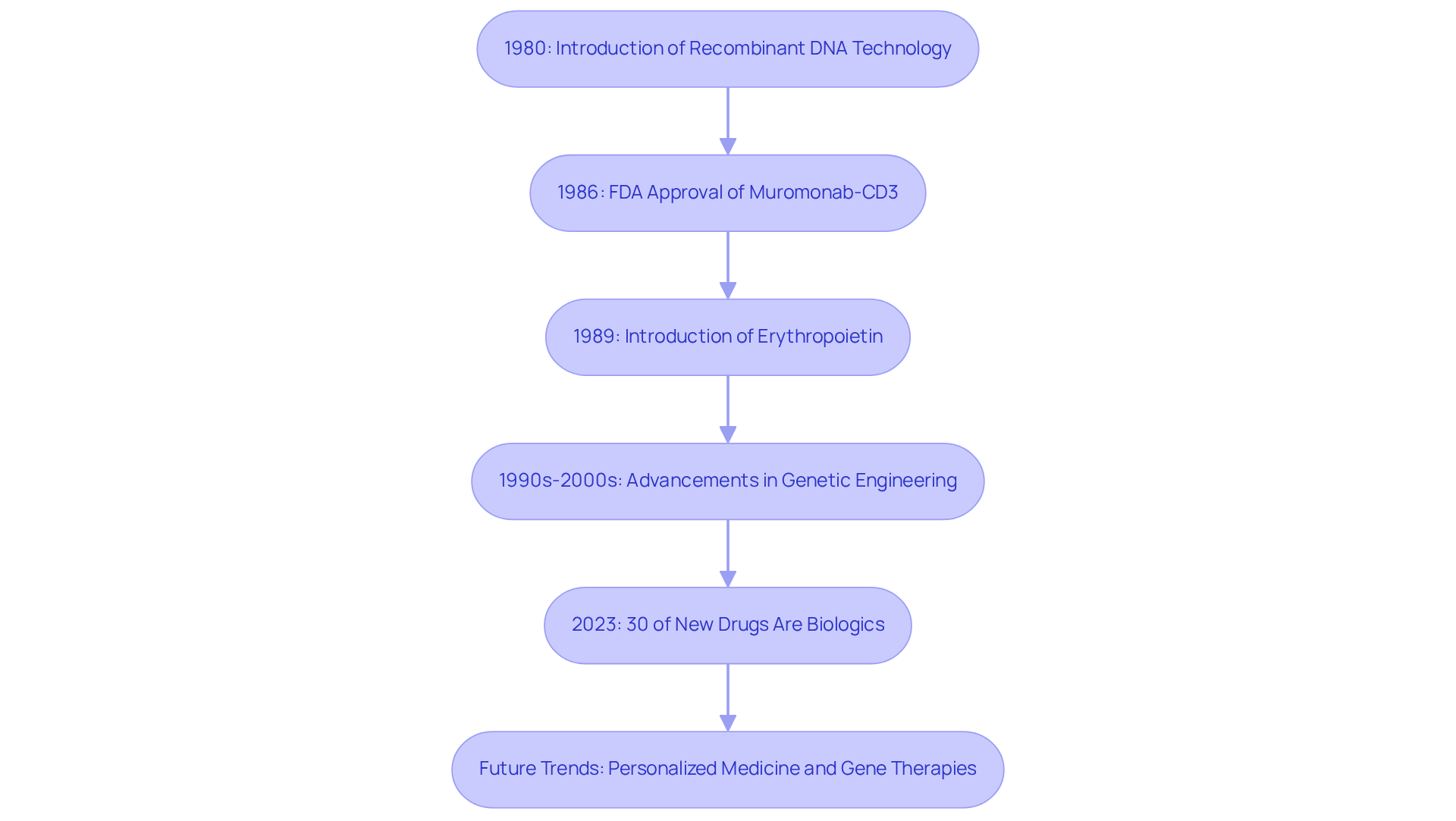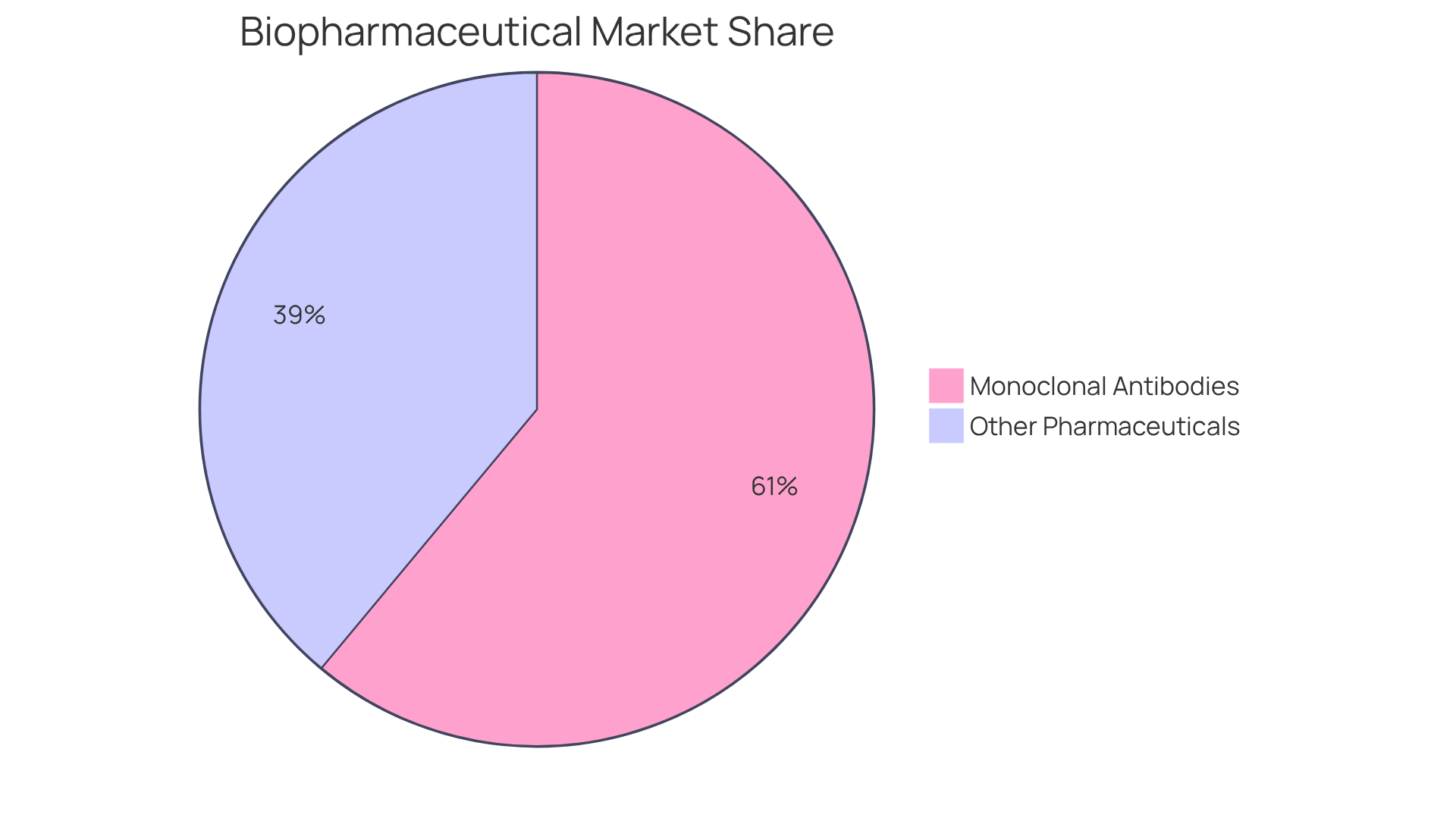Overview
Biopharmaceuticals represent a pivotal category of medicinal products, developed through advanced biotechnology that leverages biological sources such as proteins and living cells. This innovative approach distinctly sets them apart from traditional chemically synthesized drugs. Their significance is underscored by their inherent complexity and the emergence of targeted therapies, exemplified by monoclonal antibodies designed for chronic diseases.
Furthermore, the biopharmaceutical market is poised for substantial growth, reinforcing their essential role in advancing healthcare solutions. As we navigate the evolving landscape of medicine, the impact of biopharmaceuticals cannot be overstated.
Introduction
Biopharmaceuticals signify a transformative advancement in medicine, emerging from the sophisticated domain of biotechnology, where living organisms are utilized to develop effective treatments. These biologically derived products, such as monoclonal antibodies and therapeutic proteins, provide distinct advantages over traditional pharmaceuticals, particularly in their capacity to precisely target complex diseases. However, as the biopharmaceutical landscape evolves, a critical question emerges: how can the industry reconcile the swift pace of innovation with the essential need for accessibility and affordability in healthcare?
Define Biopharmaceuticals: Key Characteristics and Components
What are biopharmaceuticals? They represent a groundbreaking category of medicinal products developed through biotechnology, which involves the manipulation of living organisms or their components to formulate effective drugs. Unlike conventional pharmaceuticals, produced via chemical synthesis, biopharmaceuticals stem from biological sources such as proteins, nucleic acids, and living cells. This distinction underscores their unique characteristics, including complexity and specificity, which necessitate stringent regulatory oversight to guarantee safety and efficacy.
Key components of biopharmaceuticals encompass:
- Monoclonal antibodies
- Therapeutic proteins
- Vaccines
Notably, monoclonal antibodies accounted for 61.05% of the pharmaceutical sector share in 2024, underscoring their pivotal role in tackling complex diseases such as cancer and autoimmune disorders. The global biomedicine industry is poised for significant expansion, projected to reach approximately USD 740.84 billion by 2030, with a compound annual growth rate (CAGR) of 8.87% from 2025 to 2030, driven by escalating demand for targeted therapies and advancements in biotechnology. Furthermore, the U.S. drug market size is anticipated to surpass USD 635.37 billion by 2034, highlighting the considerable growth potential within this sector.
Experts in the field underscore the intricate nature of biopharmaceuticals, emphasizing that their development demands a profound understanding of biological processes and the specific requirements of patients. This complexity accentuates the importance of ongoing research and innovation in the pharmaceutical domain, which is vital for addressing unmet medical needs and improving healthcare outcomes. As industry leaders have pointed out, striking a balance between innovation, accessibility, and affordability remains a critical challenge within the biopharmaceutical landscape.

Trace the Evolution of Biopharmaceuticals: Historical Context and Milestones
The development of biological drugs commenced in the early 1980s, heralded by the revolutionary introduction of recombinant DNA technology. This innovation facilitated the production of vital therapeutic proteins, including insulin and growth hormones. A pivotal milestone was reached in 1986 with the FDA's approval of muromonab-CD3, the first monoclonal antibody, which represented a significant advancement in targeted therapies. This progress continued with the introduction of erythropoietin in 1989, a therapeutic protein that transformed the management of anemia.
The 1990s and 2000s witnessed rapid advancements in genetic engineering and cell culture methods, leading to a diverse array of biopharma products, such as monoclonal antibodies and therapeutic proteins. By 2023, biologics comprised approximately 30% of all new drugs approved, underscoring their increasing significance in modern medicine. In that same year, the FDA approved 55 novel drugs, with 36% classified as first-in-class treatments, reflecting the industry's unwavering commitment to innovation.
The approval rates for biological medicines have markedly increased since the 1980s. The average number of new drugs authorized from 2010 to 2019 was 60% higher than the annual average during the preceding decade. This trajectory illustrates what are biopharmaceuticals as a dynamic landscape and the ongoing dedication to advancing healthcare solutions. Furthermore, the pharmaceutical industry is projected to grow at a CAGR of 7.41%, indicating a robust future for what are biopharmaceuticals.
Today, the industry stands at the forefront of innovation, with personalized medicine and gene therapies emerging as key trends. This shift signifies a movement towards more targeted and effective care options, reinforcing the importance of continued investment in biopharmaceutical advancements.

Highlight the Importance of Biopharmaceuticals: Impact on Healthcare and Treatment
What are biopharmaceuticals, and how have they fundamentally transformed the landscape of disease management, particularly for chronic and complex conditions such as cancer, autoimmune disorders, and genetic diseases? Their capacity to precisely target specific biological pathways results in more efficient and less harmful alternatives compared to conventional therapies. For instance, monoclonal antibodies, which accounted for 61.05% of the pharmaceutical sector share in 2024, emerged as vital resources in cancer treatment, delivering targeted interventions that safeguard healthy cells from damage.
Moreover, biologic drugs are at the forefront of innovations in personalized medicine, facilitating solutions tailored to the unique characteristics of individual patients. The global biopharmaceutical sector size was estimated at USD 452.21 billion in 2024 and is projected to experience substantial growth, reaching approximately USD 762 billion by 2029. The increasing market share of biopharmaceuticals within the global pharmaceutical industry underscores their essential role in shaping the future of healthcare, particularly in addressing the escalating prevalence of chronic diseases and an aging population, which are propelling demand for innovative treatment solutions.

Conclusion
Biopharmaceuticals signify a transformative advancement in the medical field, stemming from biotechnology and biological sources. Unlike traditional pharmaceuticals, these innovative drugs provide targeted therapies that tackle complex diseases with enhanced specificity and efficacy. The distinct nature of biopharmaceuticals demands rigorous regulatory frameworks to guarantee their safety and effectiveness, underscoring their critical role in modern healthcare.
Key insights into biopharmaceuticals reveal essential components, such as:
- Monoclonal antibodies
- Therapeutic proteins
These are vital in treating chronic conditions like cancer and autoimmune disorders. The historical context highlights a rapid evolution since the 1980s, marked by significant milestones like the advent of recombinant DNA technology and the approval of groundbreaking therapies. The projected growth of the biopharmaceutical market accentuates its increasing importance in meeting unmet medical needs and broadening treatment options.
As the industry forges ahead, the focus on personalized medicine and targeted therapies remains paramount. The ongoing investment in biopharmaceutical research not only promises to reshape treatment paradigms but also addresses the challenges of accessibility and affordability. Embracing the potential of biopharmaceuticals is essential for advancing healthcare solutions and enhancing patient outcomes in an ever-evolving medical landscape.
Frequently Asked Questions
What are biopharmaceuticals?
Biopharmaceuticals are a category of medicinal products developed through biotechnology, involving the manipulation of living organisms or their components to create effective drugs. They differ from conventional pharmaceuticals, which are produced via chemical synthesis, as biopharmaceuticals originate from biological sources such as proteins, nucleic acids, and living cells.
What are the key components of biopharmaceuticals?
The key components of biopharmaceuticals include monoclonal antibodies, therapeutic proteins, and vaccines.
What role do monoclonal antibodies play in biopharmaceuticals?
Monoclonal antibodies are significant in the pharmaceutical sector, accounting for 61.05% of the market share in 2024. They are essential for addressing complex diseases, including cancer and autoimmune disorders.
What is the projected growth of the global biomedicine industry?
The global biomedicine industry is projected to reach approximately USD 740.84 billion by 2030, with a compound annual growth rate (CAGR) of 8.87% from 2025 to 2030, driven by increasing demand for targeted therapies and advancements in biotechnology.
What is the anticipated size of the U.S. drug market by 2034?
The U.S. drug market size is expected to surpass USD 635.37 billion by 2034, indicating significant growth potential in the biopharmaceutical sector.
What challenges do experts identify in the biopharmaceutical industry?
Experts highlight the intricate nature of biopharmaceuticals, emphasizing that their development requires a deep understanding of biological processes and patient needs. A critical challenge in the industry is balancing innovation, accessibility, and affordability.




